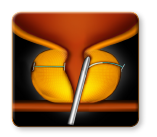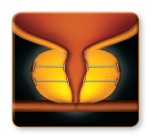UroLift® System
What is the UroLift System?The UroLift® System treatment is a revolutionary, minimally invasive approach to treating an enlarged prostate, or BPH, that lifts or holds the enlarged prostate tissue out of the way so it no longer blocks the urethra. There is no cutting, heating or removal of prostate tissue.
Clinical data has shown that the UroLift System treatment is safe and effective in relieving lower urinary tract symptoms due to BPH without compromising sexual function1,4. The goal of the UroLift System treatment is to relieve symptoms so you can get back to your life and resume your daily activities.
Most common side effects are light blood in the urine, some pain or discomfort when urinating, some increased urge to go and discomfort in the pelvis that typically resolve within two to four weeks after the procedure.
Advantages of the UroLift System:
• Rapid symptom relief, better than reported for medications • Risk profile better than reported for surgical procedures such as TURP • Preservation of sexual function • Return to normal activity in days not months • Increased quality of life • No ongoing BPH medications • 19 clinical study publications; 5 years published clinical data.How the UroLift works:
The UroLift System treatment is a straightforward procedure that is performed by a urologist. The urologist places tiny implants to hold the prostate lobes apart, like open curtains on a window, to relieve compression on the urethra. This allows urine to flow normally again. The UroLift System treatment can be done in the physician’s office under local anesthesia. Typically, patients return home the same day without a catheter.
How the UroLift System Works

The UroLift Device is placed through the obstructed urethra to access the enlarged prostate.

Small UroLift Implants are permanently placed to lift and hold the enlarged prostate tissues out of the way and increase the opening of the urethra. The permanent implants are delivered through a small needle that comes out of the UroLift delivery device and into the prostate.

The UroLift delivery device is removed, leaving an open urethra designed to provide symptom relief.

UroLift® Center of Excellence
Dr Kenworthy is the first physician in the Houston area to earn this exclusive award. His designation as a Center of Excellence is based on achieving a high level of training and experience with the UroLift System, consistently delivering excellent patient outcomes with UroLift®, and providing exemplary overall care to men suffering from urinary tract symptoms.

Urolift Featured in Golf Digest Magazine
Urolift and Northwoods Urology was recently featured in nationally printed Golf Digest Magazine. Dr. Kenworthy is one of just two physicians in Texas listed in the magazine. Read the Golf Digest Feature here.

American Urological Association (AUA) Study on UroLift®
Message from Dr. Kenworthy:
"At Northwoods Urology of Texas, we are continuing the most up to date care using the Urolift system for patients with benign prostatic hyperplasia (BPH). As Houston's First Center of Excellence physician for this BPH treatment, I am pleased to provide our patients and all within our Northwoods family, the most recent Highlights presented at the 2019 AUA annual meeting." - Dr. Paul Kenworthy
UroLift® Official Release:
We are excited to announce new clinical data at the American Urological Association (AUA) 2019 Annual Meeting from five studies of the UroLift® System for patients with benign prostatic hyperplasia (BPH) were presented this year, showcasing the safety and effectiveness of the minimally invasive treatment in real-world patient populations.
Teleflex announced the highlights from each presentation in a press release earlier today, which can be found below.
UroLift® System – Results from Five Studies Presented at the American Urological Association (AUA) 2019 Underscored the Effectiveness and Versatility of the UroLift System Treatment for BPH
View the study on their websiteUroLift® System
What is the UroLift System?The UroLift® System treatment is a revolutionary, minimally invasive approach to treating an enlarged prostate, or BPH, that lifts or holds the enlarged prostate tissue out of the way so it no longer blocks the urethra. There is no cutting, heating or removal of prostate tissue.
Clinical data has shown that the UroLift System treatment is safe and effective in relieving lower urinary tract symptoms due to BPH without compromising sexual function1,4. The goal of the UroLift System treatment is to relieve symptoms so you can get back to your life and resume your daily activities.
Most common side effects are light blood in the urine, some pain or discomfort when urinating, some increased urge to go and discomfort in the pelvis that typically resolve within two to four weeks after the procedure.
Advantages of the UroLift System:
• Rapid symptom relief, better than reported for medications • Risk profile better than reported for surgical procedures such as TURP • Preservation of sexual function • Return to normal activity in days not months • Increased quality of life • No ongoing BPH medications • 19 clinical study publications; 5 years published clinical data.How the UroLift works:
The UroLift System treatment is a straightforward procedure that is performed by a urologist. The urologist places tiny implants to hold the prostate lobes apart, like open curtains on a window, to relieve compression on the urethra. This allows urine to flow normally again. The UroLift System treatment can be done in the physician’s office under local anesthesia. Typically, patients return home the same day without a catheter.
How the UroLift System Works

The UroLift Device is placed through the obstructed urethra to access the enlarged prostate.

Small UroLift Implants are permanently placed to lift and hold the enlarged prostate tissues out of the way and increase the opening of the urethra. The permanent implants are delivered through a small needle that comes out of the UroLift delivery device and into the prostate.

The UroLift delivery device is removed, leaving an open urethra designed to provide symptom relief.

UroLift® Center of Excellence
Dr Kenworthy is the first physician in the Houston area to earn this exclusive award. His designation as a Center of Excellence is based on achieving a high level of training and experience with the UroLift System, consistently delivering excellent patient outcomes with UroLift®, and providing exemplary overall care to men suffering from urinary tract symptoms.
Urolift Featured in Golf Digest Magazine
Urolift and Northwoods Urology was recently featured in nationally printed Golf Digest Magazine. Dr. Kenworthy is one of just two physicians in Texas listed in the magazine. Read the Golf Digest Feature here.


American Urological Association (AUA) Study on UroLift®
Message from Dr. Kenworthy:
"At Northwoods Urology of Texas, we are continuing the most up to date care using the Urolift system for patients with benign prostatic hyperplasia (BPH). As Houston's First Center of Excellence physician for this BPH treatment, I am pleased to provide our patients and all within our Northwoods family, the most recent Highlights presented at the 2019 AUA annual meeting." - Dr. Paul Kenworthy
UroLift® Official Release:
We are excited to announce new clinical data at the American Urological Association (AUA) 2019 Annual Meeting from five studies of the UroLift® System for patients with benign prostatic hyperplasia (BPH) were presented this year, showcasing the safety and effectiveness of the minimally invasive treatment in real-world patient populations.
Teleflex announced the highlights from each presentation in a press release earlier today, which can be found below.
UroLift® System – Results from Five Studies Presented at the American Urological Association (AUA) 2019 Underscored the Effectiveness and Versatility of the UroLift System Treatment for BPH
View the study on their websiteUroLift® System
What is the UroLift System?The UroLift® System treatment is a revolutionary, minimally invasive approach to treating an enlarged prostate, or BPH, that lifts or holds the enlarged prostate tissue out of the way so it no longer blocks the urethra. There is no cutting, heating or removal of prostate tissue.
Clinical data has shown that the UroLift System treatment is safe and effective in relieving lower urinary tract symptoms due to BPH without compromising sexual function1,4. The goal of the UroLift System treatment is to relieve symptoms so you can get back to your life and resume your daily activities.
Most common side effects are light blood in the urine, some pain or discomfort when urinating, some increased urge to go and discomfort in the pelvis that typically resolve within two to four weeks after the procedure.
Advantages of the UroLift System:
• Rapid symptom relief, better than reported for medications • Risk profile better than reported for surgical procedures such as TURP • Preservation of sexual function • Return to normal activity in days not months • Increased quality of life • No ongoing BPH medications • 19 clinical study publications; 5 years published clinical data.How the UroLift works:
The UroLift System treatment is a straightforward procedure that is performed by a urologist. The urologist places tiny implants to hold the prostate lobes apart, like open curtains on a window, to relieve compression on the urethra. This allows urine to flow normally again. The UroLift System treatment can be done in the physician’s office under local anesthesia. Typically, patients return home the same day without a catheter.
How the UroLift System Works

The UroLift Device is placed through the obstructed urethra to access the enlarged prostate.

Small UroLift Implants are permanently placed to lift and hold the enlarged prostate tissues out of the way and increase the opening of the urethra. The permanent implants are delivered through a small needle that comes out of the UroLift delivery device and into the prostate.

The UroLift delivery device is removed, leaving an open urethra designed to provide symptom relief.

UroLift® Center of Excellence
Dr Kenworthy is the first physician in the Houston area to earn this exclusive award. His designation as a Center of Excellence is based on achieving a high level of training and experience with the UroLift System, consistently delivering excellent patient outcomes with UroLift®, and providing exemplary overall care to men suffering from urinary tract symptoms.

Urolift Featured in Golf Digest Magazine
Urolift and Northwoods Urology was recently featured in nationally printed Golf Digest Magazine. Dr. Kenworthy is one of just two physicians in Texas listed in the magazine. Read the Golf Digest Feature here.

American Urological Association (AUA) Study on UroLift®
Message from Dr. Kenworthy:
"At Northwoods Urology of Texas, we are continuing the most up to date care using the Urolift system for patients with benign prostatic hyperplasia (BPH). As Houston's First Center of Excellence physician for this BPH treatment, I am pleased to provide our patients and all within our Northwoods family, the most recent Highlights presented at the 2019 AUA annual meeting." - Dr. Paul Kenworthy
UroLift® Official Release:
We are excited to announce new clinical data at the American Urological Association (AUA) 2019 Annual Meeting from five studies of the UroLift® System for patients with benign prostatic hyperplasia (BPH) were presented this year, showcasing the safety and effectiveness of the minimally invasive treatment in real-world patient populations.
Teleflex announced the highlights from each presentation in a press release earlier today, which can be found below.
UroLift® System – Results from Five Studies Presented at the American Urological Association (AUA) 2019 Underscored the Effectiveness and Versatility of the UroLift System Treatment for BPH
View the study on their websiteUroLift® System Frequently Asked Questions
Non-clinical testing has demonstrated that the UroLift Implant is MR Conditional. That means that you can be safely scanned in an MR system meeting the following conditions:
• Static magnetic field of 3 Tesla or less • Maximum spatial gradient magnetic field of 1500 Gauss/cm (15 T/m) or less • Maximum MR system reported, whole body averaged specific absorption rate (SAR) of 4 W/kg (First Level Controlled Mode)
Under the scan conditions defined above, the UroLift implant is expected to produce a maximum temperature rise of 2.4°C after 15 minutes of continuous scanning.
In non-clinical testing, the image artifact caused by the device extends approximately 15 mm from the UroLift Implant when imaged with a gradient echo pulse sequence and a 3 Tesla MRI system.
Patient implant cards are provided to inform the patient that the UroLift implant is MR Conditional and can safely be scanned only under specific MR conditions.
If you have any questions about MRI safety, please consult your doctor.
NeoTract, Inc. manufactures the UroLift System. The company is based in Pleasanton, California.
1. Roehrborn 2016 Urology Clinics 2. Roehrborn, 2015 Canadian Journal of Urology, 3-Year Results L.I.F.T. Study 3. Roehrborn, 2013 Journal of Urology, L.I.F.T Study 4. McVary, 2014 Journal of Sexual Medicine, Preservation of sexual function with the prostatic urethral lift
Dr. Kenworthy's talks Urolift on Great Day Houston
UroLift Videos
UroLift® System Frequently Asked Questions
Non-clinical testing has demonstrated that the UroLift Implant is MR Conditional. That means that you can be safely scanned in an MR system meeting the following conditions:
• Static magnetic field of 3 Tesla or less • Maximum spatial gradient magnetic field of 1500 Gauss/cm (15 T/m) or less • Maximum MR system reported, whole body averaged specific absorption rate (SAR) of 4 W/kg (First Level Controlled Mode)
Under the scan conditions defined above, the UroLift implant is expected to produce a maximum temperature rise of 2.4°C after 15 minutes of continuous scanning.
In non-clinical testing, the image artifact caused by the device extends approximately 15 mm from the UroLift Implant when imaged with a gradient echo pulse sequence and a 3 Tesla MRI system.
Patient implant cards are provided to inform the patient that the UroLift implant is MR Conditional and can safely be scanned only under specific MR conditions.
If you have any questions about MRI safety, please consult your doctor.
NeoTract, Inc. manufactures the UroLift System. The company is based in Pleasanton, California.
1. Roehrborn 2016 Urology Clinics 2. Roehrborn, 2015 Canadian Journal of Urology, 3-Year Results L.I.F.T. Study 3. Roehrborn, 2013 Journal of Urology, L.I.F.T Study 4. McVary, 2014 Journal of Sexual Medicine, Preservation of sexual function with the prostatic urethral lift


